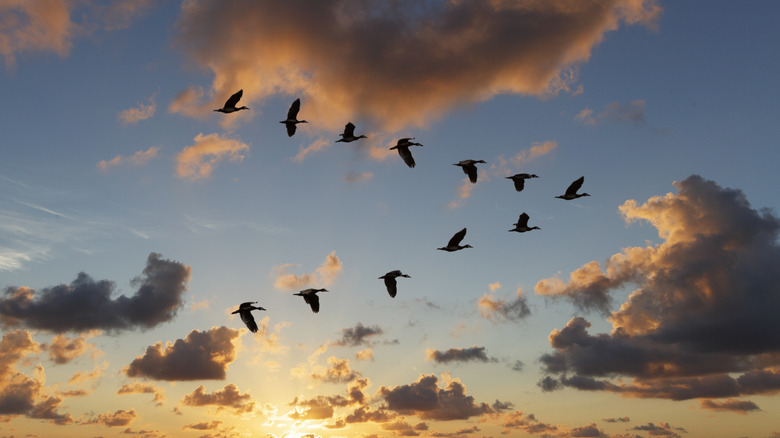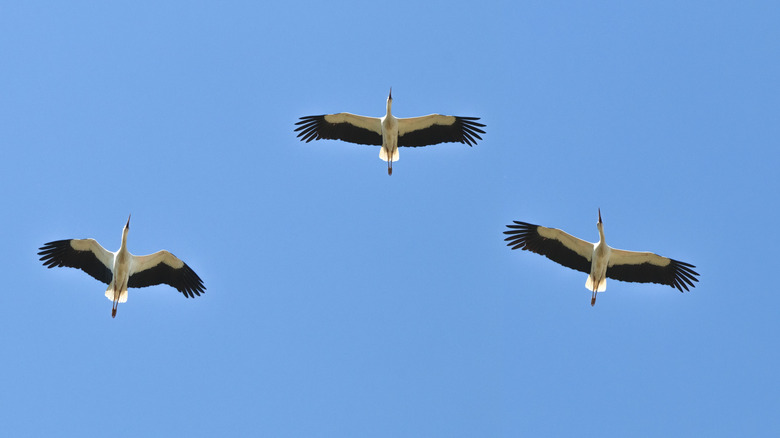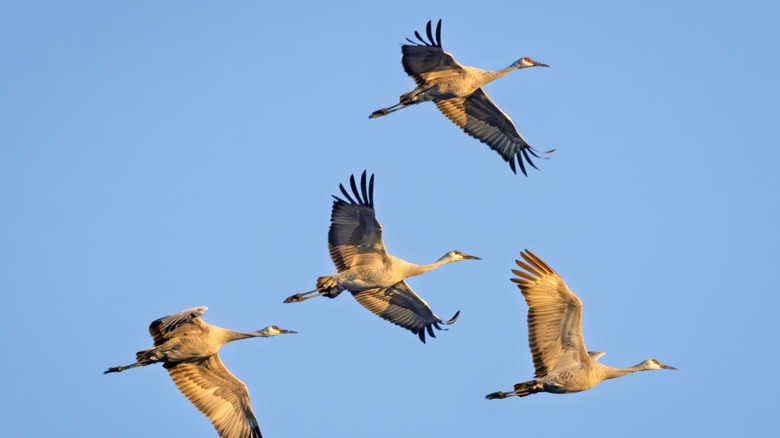The Reason Why Birds Fly In A V Shape
Remember when you were a kid and you looked up at the sky to see dozens of geese soaring overhead in a V shape? "Why do they do that?" you probably wondered. Seeing birds — from geese to pelicans and all sorts of other migratory species — moving in unison as their wings beat in rhythmic patterns is as mesmerizing to adults as it is to younger generations. But seriously, why do they do it? As it turns out, flying in a V shape is far more than just instinctive behavior; it's a sophisticated survival strategy rooted in physics and group aerodynamics.
For years, this question remained one of scientists' most perplexing, not unlike the question of how migrating birds know where to go each year. But in the last 10 years, research has begun to reveal the specifics of why birds do this. The main reason birds fly in a V formation is to maximize aerodynamic efficiency. By flying in a V, each bird takes advantage of the upward lift generated by the wingtip vortices of the bird in front of it. A wingtip vortex is a spiraling column of air that creates drag, a force that birds and airplanes have to overcome to stay aloft. When air moves over a wingtip, it creates a swirl of air that moves off the wingtip — that's a wingtip vortex.
By positioning themselves in a V shape, birds reduce wind resistance, allowing those behind to expend less energy while keeping pace. So, it's not wholly unlike cyclists drafting off one another in a race, it's just tailored to the presence of wings. But the V formation is about more than just saving energy. It also helps with navigation and maintaining group cohesion, allowing birds to communicate, see each other clearly, and keep a steady formation.
The science behind the V formation
Birds flying in a V formation aren't simply saving energy; they're perfectly coordinating their movements to maximize the aerodynamic benefits. A 2014 study by researchers at the Royal Veterinary College at the University of London showed just how precise this coordination is. Scientists tracked a group of northern bald ibises during migration, monitoring the flight patterns of each bird in the group, including every single wing flap.
By outfitting the birds with small data recorders, researchers found that the birds behind the leader in the flock position themselves to best take advantage of what's called the "upwash" — upward flowing air — created by the bird at the front. Conversely, "downwash" is created when air flows over the mid-section of a bird's wing. But the tip of the wing is where the upwash occurs, and any bird that has positioned their wing near the tip of another's is in for a much easier ride. Even more incredibly, the birds appeared to time their own wingbeats accordingly, matching the good air coming off the birds toward the front of the group. The result is that, somewhat counterintuitively, birds who flap their wings in this V formation are expending less energy than they would simply by coasting.
Other studies have indicated that, if birds time their wingbeats properly, they can save upwards of 20% of their energy while flying — a massive help when you're covering thousands of miles in a seasonal migration. The phenomenon showcases a remarkable feat of precision and instinctive teamwork. The study builds on earlier work conducted by researchers at the French National Centre for Scientific Research. In a 2001 paper, scientists demonstrated that when a group of great white pelicans flew together in V formation, their heart rates lowered significantly.
Bird teamwork, navigation, and why it matters
One of the most intriguing aspects of V-formation flight is how the leadership role shifts within the flock. The bird at the front, which faces the greatest air resistance, eventually tires and moves to the back, while another bird takes its place. A 2015 study by researchers at the University of Bern demonstrated that birds flying in the V not only take turns flying at the front position, but they are careful to match the amount of time they spend flying at the back as they do at the front. The study even suggests that the more likely birds are to reciprocate, the more cohesive and organized the flight is likely to be, a critical component of a successful migration.
Long-distance migrations are grueling affairs. Research has shown that bird mortality rates are up to six times higher during migratory seasons, with common causes of death often due to exhaustion, starvation, predation, and disease. Any energy-saving technique birds can employ might mean the difference between life and death. Scientists also suspect that birds use the V formation to help with communication and organization during long flights. By flying in formation, birds can keep a clear line of sight to one another, something that can help maintain spacing and prevent collisions (here's why birds fly into windows).
Not all migrating bird species fly in formation, however. Smaller birds, like hummingbirds and sparrows, are simply too small to get any energy-saving lift from flying in any formation. So, the next time you look up and see a flock in a perfect V, remember that this formation is a sophisticated blend of teamwork and survival strategy. The term "bird-brained" just doesn't hold up — even pigeons aren't stupid (here's why their nests look so horrible, though).


